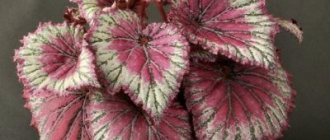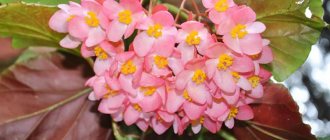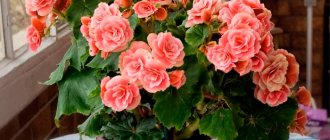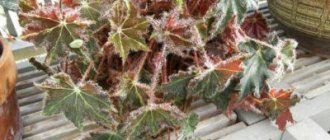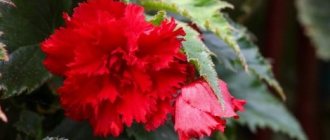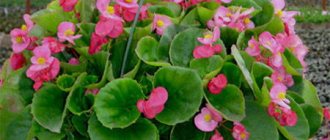Among other rhizome species, Tiger or Bauer begonia stands out due to its attractive appearance and easy care. It may not be as spectacular as the Royal one, but some gardeners like it even more than Mason or Imperial begonias. Unlike them, Bauer’s appearance is not capricious, it can stand on a refrigerator or any window sill, and in summer it will decorate a not too sunny balcony.
Botanical description
Bower's begonia (Begonia bowerae) is native to tropical Mexico and has several natural varieties and many cultivars. For some reason, in the post-Soviet space, the name Tiger has become synonymous with it, although only the pattern of naturally shaped leaves resembles the stripes. And even remotely, to see it, you need to turn on your imagination. Numerous cultivars are usually covered with expressive spots, more likely leopard than tiger.
In English-language sources, Bauer's begonia is often called “ciliated,” which more accurately describes its appearance.
What does a bush look like?
Bauer's species begonia is a rhizomatous, evergreen, perennial plant. It is grown in culture for its beautiful leaves, has several natural forms, many varieties and hybrids, including interspecific ones.
Tiger begonia reaches a height of 25-30 cm, diameter in a pot is 20-25 cm. When placed in wide containers, the creeping stem spreads over a large area. But usually bushes are planted this way only in botanical gardens to show the growth pattern of the crop.
Bauer's begonia is a rhizomatous species. Rhizome is a thick modified stem, covered with scars from fallen leaves, adventitious roots are fibrous, weak, located close to the surface.
Young shoots initially grow vertically or at a slight angle to the ground, but quickly take a horizontal position. Tiger Begonia stems droop when they extend beyond the pot. Without trimming, the flower turns into an ampel.
The culture is growing very quickly. In 2-3 years, with proper care, a small cutting turns into a lush bush, which becomes cramped on the windowsill.
Without pinching or pruning, there is usually only one growth point - at the end of the stem. To induce tillering, it is removed, dormant buds awaken on the rhizome, and new rosettes appear.
The culture is valued for its beautiful leaves. Compared to other rhizomatous begonias, the Bauer species is relatively small, the maximum length reaching 10 cm, width up to 4-6 cm.
The plates are located on petioles of medium thickness, which can grow straight up, bend or slope down. With insufficient lighting or improper care, they become very elongated, which does not always add decorative value to the bush.
The asymmetry of the plates of Bauer begonia is clearly visible, the shape is oblique-heart-shaped, the tip is sharp, elongated, the edge is serrated, with rare triangular protrusions. The petiole and edge are decorated with long hairs similar to eyelashes.
The underside of the leaf is light with reddish veins. The front side of young plates of Tiger Begonia is glossy, bright green; in mature ones it becomes emerald, matte. Along the edge there are dark chocolate spots that appear black. They are densely located, uneven, floating towards the center, which is why they look like an edging with transverse stripes.
The colors of the varieties and varieties are not radically different; Tiger begonia is unmistakably visible in the plants.
Bauer's begonia blooming
With proper care, the crop blooms annually. Typically, loose clusters with small white buds on long pinkish stems appear in late winter or early spring. They are unstable, can grow upward, bend or bend at any angle, and sometimes even fall down.
In terms of decorativeness, the corollas are significantly inferior to the foliage. In order not to deplete the bush, experienced indoor plant lovers break off flower stalks as soon as they appear.
Medicinal properties
In folk medicine, begonia is used to treat:
- Alcoholism. The use of the decoction causes gag reflexes followed by aversion to alcohol. Treatment is carried out by adding the medicine to the patient’s food or drinks.
- Melancholy. The flower is useful for people who take everything to heart with or without reason.
- Depression. Has a positive effect Being in a room where flowers are present gives amazing results.
Observations record: begonia can be used as an absorber, concentrating all negative energy. This is a great gift for people with emotional and mental disabilities.
Natural varieties and varieties
Bauer's begonia has several varieties (ecological races). In culture there are:
- Begonia bowerae var. Major with smoothly colored shiny plates;
- B. bowerae var. nigramarga - a variety with small, rugged leaves that turn almost black with good care, and long “cilia” along the edges;
- bowerae var. Roseflora with pink flowers.
Among potted plants you can find a red-leaved natural form. It was found in an area geographically isolated from the main species – Begonia bowerae f. Rubra.
Of the varieties in popularity, the palm belongs to the Bauer Tiger begonia (Tiger). This is a beautiful plant, usually grown as an ampel. Reaches a height of 10 cm. The leaves are velvety, with long “cilia” along the serrated edge, similar to an oblique heart with a sharp tip.
Tiger
The coloring differs from the species, reminiscent of a leopard, not a tiger:
- yellowish-light green round or oval spots are located close to the edges;
- the main background is dark green, in intense lighting it is bronze.
The remaining Bauer varieties differ in the shape, location, color of the spots and the color of the main background - from yellowish through all shades of green to brown and purple. The size or degree of ruggedness of the leaves may vary. The corollas are white to pink, usually in pale shades.
Black Velvet
Popular varieties and hybrids of Bauer begonia:
- Cleopatra;
- Black Velvet;
- Apple Pie;
- Rhinestone Jeans;
- China Doll;
- Chantilly Leys;
- Vov-Arriola;
- Chaichi;
- Leprechaun;
- Persian Brocade;
- Kosmatka;
- Abu Dhabi;
- Apache;
- Bethlehem Star;
- Little Darling.
Bloom
Interest and curiosity is aroused by the fact that begonia flowers have different sexes - male and female. They can be distinguished by the following characteristics:
- in females there is a small growth on the bottom where a box with seeds will appear;
- the male one does not have it, and his flowers are double, although not always.
During this period, it is necessary to intensively water the blooming beauty, providing access to the sun and microelements.
Home care
Bauer's varieties and hybrids, compared to most rhizome begonias, are considered unpretentious and easy to care for. But this does not mean that the plant can be “planted and forgotten.”
Lighting and temperature
Tiger Begonia needs bright diffused light or light partial shade when caring for it at home. With a lack of lighting, the pattern on the leaves turns pale and the petioles become very elongated. In deep shade, the plant may die. But under direct rays, the plates get burned, dark spots lose contrast, and even with proper care, the bush seems lethargic.
Under artificial light, Bauer's begonia grows well. The main thing is that it is intense, and the duration does not exceed 12 hours a day - this is a plant of short daylight hours.
If the sun hits the flower from the side, the bush becomes deformed. Every week the pot is turned a quarter turn relative to the light source, and in order not to get confused when leaving, do this only clockwise or counterclockwise.
Tiger begonia loves cool weather, grows well at temperatures of 18-21° C. In winter, a decrease is possible, but not less than 15° C. Heat of 26° C or more leads to a stop in development, life processes freeze.
The plant loves frequent ventilation and can stand on a cool balcony in summer. It is not advisable to take it outside. Tiger Begonia should be protected from cold drafts.
Humidity and watering
Irrigation throughout the season is best done abundantly, but infrequently. The earth ball should dry out 1/3 or 1/2 between waterings. The soil that is wet on top should not be moistened even a little - the crop is prone to root rot, which must be taken into account when caring.
In winter, watering is reduced. But the earthen lump should not dry out completely.
Low humidity is more likely to lead to the loss of decorative properties of Tiger Begonia than to the death of the plant. Since you can’t spray the leaves, you can increase it in one of the following ways:
- place low, wide vessels with water nearby;
- place the pot on wet pebbles, expanded clay, sphagnum;
- in winter, hang a damp terry towel on the radiator;
- buy a household humidifier;
- spray several times a day around the plant so that the liquid does not get on the leaves.
In the cold season, if the room is hot, air humidity must be monitored especially carefully. With a cool wintering of Bauer begonia, on the contrary, you can forget about this.
The water should not contain chlorine, be soft, and the temperature should be several degrees higher than in the room. Tap or hard well:
- filter;
- frozen;
- defend;
- boil.
Feeding
When caring for Tiger Begonia, use chlorine-free fertilizers for decorative foliage plants. They are used from spring to early autumn every 2-3 weeks, on wet soil.
In the cold season, feeding is stopped. Only first-year plants grown from leaves are given a half dose of fertilizer once a month during the first winter.
Trimming
Over time, rhizome begonias, including Bauer's and Tiger's begonias, lose their stems. This is a natural process; even with ideal care, the leaves live no more than 3 years, then they fall off.
As long as the indoor flower looks good, the bush can be left alone, especially if it is dense, and the bare bases of the shoots are covered by leafy branches. Sometimes the owners themselves carefully bend and hide the “bald” stems when leaving.
To maintain decorativeness, pruning is carried out, leaving a column of about 5 cm. Soon the sleeping buds will awaken on it, Tiger Begonia will begin to actively bush, sprout new rosettes and leaves.
The cut shoot is allowed to propagate by cuttings.
This is also a rejuvenation of the bush. Experienced gardeners usually do the following:
- All old stems on one half of the Bauer begonia are cut off.
- The exposed side is unfolded so that it is not conspicuous. In about a month it will grow well and become attractive.
- Tidy up the second half of the bush.
The care package must include the timely removal of worn-out plates: they not only spoil the appearance, but can rot.
It is better to break off the stems with buds immediately - flowering greatly depletes the plant. Bauer's begonia will require attention and additional feeding, and the good thing about the culture is that it is beautiful with minimal care.
Illumination
An indoor flower should be placed in the house so that it has enough light. It is better to place the pot with the plant in a well-lit, warm room. You can place a pot or flowerpot with a crop on a windowsill, but care should be taken to ensure that the burning rays of the sun do not fall on the bush, otherwise burns cannot be avoided. Begonia tolerates bright or diffused light well, but does not tolerate shade and cold. In winter, you can connect artificial lighting for the flower in the form of fluorescent lamps.
Place the begonia pot in a southwest window.
Transfer
All begonias love moving into fresh substrate, Tiger begonia is no exception. At the same time, it is not necessary to do a complete transplant, and is not even recommended if everything is in order with the root system. Every spring:
- Take a flower out of a pot.
- Lightly knead the surface of the earthen clod.
- About 1/3 of the old soil is removed.
- Drainage is poured into a new container. It should occupy at least 1/5 of the volume.
- Straighten the roots and transfer the begonia to fresh substrate.
- Watered.
- Place in a shaded, cool place for 2-3 days. Then they take care as usual.
The pot for Tiger Begonia should be wide and low - the root of the culture is superficial. If you take a container of a regular shape, fill the “excess” space with drainage.
Every year the diameter is increased by 2-3 cm. When the bush ages, a bald spot will appear in the center, the soil must be completely removed, and the rhizome divided into parts. You will get several new begonias.
The main thing when choosing a pot is the presence of drainage holes.
The substrate can be bought in the store, based on peat, for ornamental foliage plants. Specialized “Begonia” is not suitable for Bauer varieties; beautiful flowering varieties develop well in it.
Peculiarities
At home, begonia propagates by cuttings, seeds, and tubers. But it is leaf propagation that is used most often. This is due to a large number of positive characteristics.
- Losing one leaf will not in any way affect the health or appearance of the plant.
- None of the stages requires special skills, effort or time.
- This method can be considered the most productive: after all, about 10 shoots can be obtained from one leaf plate.
- For some varieties of begonias, this reproduction option is practically the only one.
- Unlike propagation by seeds, you will know exactly what the future plant will look like.
- Planting material acts as a source of nutrition. Thanks to the beneficial substances it contains, shoots will grow faster than from seeds.
In addition, the sheet itself can be used in different ways:
- wait for the roots to appear by placing it in water;
- land in the ground.
Reproduction methods
Tiger begonia is easy to propagate vegetatively:
- Whole leaves, their fragments and “lying”, with notches across the thick veins.
- By cutting the shoots remaining after pruning.
- By dividing the rhizome when rejuvenating an old bush.
Root stem and leaf cuttings:
- in water;
- perlite;
- peat;
- light substrate.
The rhizomes of Tiger Begonia are divided into parts, dried, and germinated in low, wide bowls with drainage holes filled with peat and sand. Place on the surface of the substrate, press lightly, cover with transparent cellophane. Soon the sleeping buds will wake up, new leaves and rosettes will appear.
Amateurs usually do not propagate Bauer begonia from seeds.
Humidity
In houses where Bauer begonia is bred, it is necessary to maintain high air humidity.
The tropical bush does not tolerate dry air, so in no case should you place the container with the plant near heating devices, radiators, or stoves. Being in dry air, the moisture-loving crop will begin to dry and wither, lose its attractive appearance and stop blooming. A humidifier placed near the flower will help ensure air humidity. You can also hang a wet towel nearby or place a saucer of water.
Attention! Although the tiger beauty loves moist air, it cannot be sprayed.
Problems during cultivation
The culture is healthy, infectious diseases are rare. Most of the troubles are associated with improper care:
- leaves curl due to cold or pests;
- due to excessive watering, the roots and above-ground vegetative organs rot when water gets on them;
- leaves may fall off in high humidity and low temperatures;
- lack of nutrition slows down growth;
- from the bright sun the tiger pattern becomes unclear;
- lack of light causes the petioles to stretch and the plates to turn pale;
- The edges turn black and dry out when watered with hard water.
Pests of Tiger Begonia:
- spider mite;
- mealybugs;
- scale insects;
- thrips.
Fungicides help control diseases, and insecticides are used to eradicate pests. When fighting spider mites, drugs must have an acaricidal effect.
Folk signs
Human word of mouth spreads information about the benefits or harms of house plants better than any advertising. The literature also describes signs and superstitions associated with flowers. Let everyone decide for themselves whether to believe them or not, but it is advisable to know about it.
What begonia can offer:
- Takes on negative energy.
- Increases decisiveness in making responsible decisions and activity in action.
- Brings peace and harmony to the home.
- Rapid growth and abundant flowering - good luck awaits you.
- Unplanned flowering is a new addition to the family.
- Withering will bring misfortune.
What to do to make the bush grow thicker?
On a note. In order for geranium to grow into a lush bush, its apical bud on the main shoot above the stem node must be pinched.
This stimulates the growth of lateral buds on the lower nodes of the stem. After this event, the seedlings will slow down their growth, but will begin to gain strength. The geranium will eventually take on a beautiful spherical shape due to the appearance of many side stems.
How to prevent the flower from stretching too much upward?
To prevent geraniums from stretching out, pinching should be done at the most important upper point of stem formation. If after this procedure the shoots begin to grow again from the upper axils of the leaves, they must be removed, then allowed to grow a little and pinched back again. During this time, the buds are removed so that the flower devotes all its strength only to the growth of side shoots.
What to do for lush flowering?
Only young shoots bloom in geraniums. Therefore, in order for it to develop quickly and bloom luxuriantly, young shoots must be pinched after the formation of the first 4-5 pairs of leaves. As a result, the remaining strong shoots will begin to actively grow and develop, turning into a lush crown with many flowers.
What should I feed after pruning?
After pruning, when young shoots grow and the water regime is restored, the flower must be fed.
Overfeeding should be avoided - this leads to a change in soil acidity, and begonia is sensitive to this.
Fertilizers containing nitrogen are preferred. After the first feeding, the next one is carried out before flowering begins and then the flower is fertilized once every two weeks.
And also after pruning, in addition to fertilizing, it is necessary:
- To avoid infection, treat the cut with charcoal or activated carbon.
- Organize shading of the location of the flower.
- Reduce the amount of watering.
Trimming and pinching begonias are necessary procedures that must be carried out correctly and in a timely manner. The formation of a bush should be done from the moment a flower appears at home, then lush flowering and a beautiful crown are guaranteed to you.
What does a begonia flower look like?
The homeland of the plant is the West Indies. There, the French botanist Charles Plumier discovered this flower. He named it in honor of the organizer of that expedition - Monsieur Begon. Habitat: tropics and subtropics of Africa, Asia, South and North America. The humidity in those parts is high, so the flower is demanding when it comes to watering.
This is what begonia looks like
Perennial garden begonia, like annual begonia, is found in the form of vines, shrubs and subshrubs. Most of them are small - reaching a maximum height of 20 cm. There are also tall ones, stretching up to 35 cm. Flowering is abundant, the buds cover the entire bush.
The color and shape of the leaves depend on the variety. They come in green, olive, burgundy and pink, sometimes with pearlescent dots or streaks. The leaves of some varieties are hairy, like Begonia metallica or Begonia griffithiana.
How to care for tuberous begonia in autumn?
In the fall, begonia begins a dormant period that lasts until spring.
At this time, you need to cut off wilted leaves and shoots, reduce watering, put the plant in a cool (with a temperature of about 10 degrees) place and occasionally carefully moisten the soil. How long is the flowering period? Of all the begonias, the tuberous one is the most decorative; its flowers, depending on the variety, can be simple or double, single-colored, two-colored or bordered, small or large (up to 15 centimeters in diameter)
Tuberous begonia pleases with abundant flowering in the garden - throughout the summer, and in indoor conditions - from June to October. Begonias bloom best on a shaded balcony.
